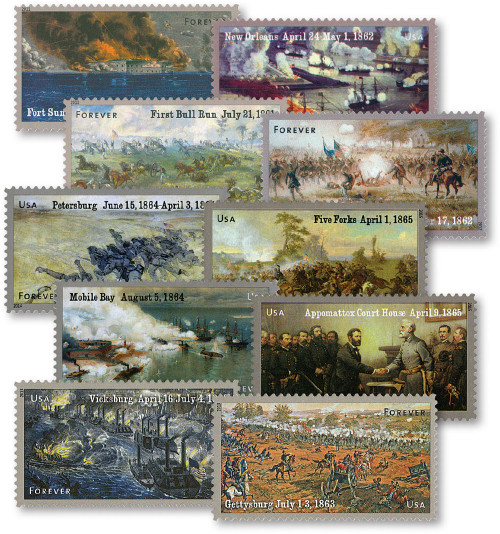
# 4522-23a - 2011 44c Civil War Sesquicentennial: 1861 - Fort Sumter and First Bull Run (Front of Sheet only)
“Lee has arrived, and our hopes are high that we will wipe them clean out this time. Lee has an army great in numbers and spirit, and I believe he will wield it greatly. He is silent, inscrutable, strong, like a god.” – Lt. John H. Chamberlayne, Confederate Army In 1861, years of heated rhetoric reached a climax and the nation spiraled into Civil War. An anti-slavery President occupied the White House, Kansas was admitted to the Union as a free state, and eleven states seceded from the Union. Men young and old were intoxicated by their desire to go to battle and eager to defend their principles. As Civil War divided the nation, the South was further divided by neighboring states holding Union and Confederate loyalties. West Virginia emerged as a new Union state, although as in many regions, sympathies varied greatly from one town to another. Union and Confederate armies assembled, often made of men with more passion than experience. Many officers were friends and former West Point classmates, including Confederate General Robert E. Lee and the opposing leaders at Fort Sumter. While Fort Sumter marked the beginning of the conflict, the bloodshed at the First Battle of Bull Run made the nation face the somber reality of a lengthy war and the widespread suffering it would inflict.
“Lee has arrived, and our hopes are high that we will wipe them clean out this time. Lee has an army great in numbers and spirit, and I believe he will wield it greatly. He is silent, inscrutable, strong, like a god.” – Lt. John H. Chamberlayne, Confederate Army In 1861, years of heated rhetoric reached a climax and the nation spiraled into Civil War. An anti-slavery President occupied the White House, Kansas was admitted to the Union as a free state, and eleven states seceded from the Union. Men young and old were intoxicated by their desire to go to battle and eager to defend their principles. As Civil War divided the nation, the South was further divided by neighboring states holding Union and Confederate loyalties. West Virginia emerged as a new Union state, although as in many regions, sympathies varied greatly from one town to another. Union and Confederate armies assembled, often made of men with more passion than experience. Many officers were friends and former West Point classmates, including Confederate General Robert E. Lee and the opposing leaders at Fort Sumter. While Fort Sumter marked the beginning of the conflict, the bloodshed at the First Battle of Bull Run made the nation face the somber reality of a lengthy war and the widespread suffering it would inflict.











